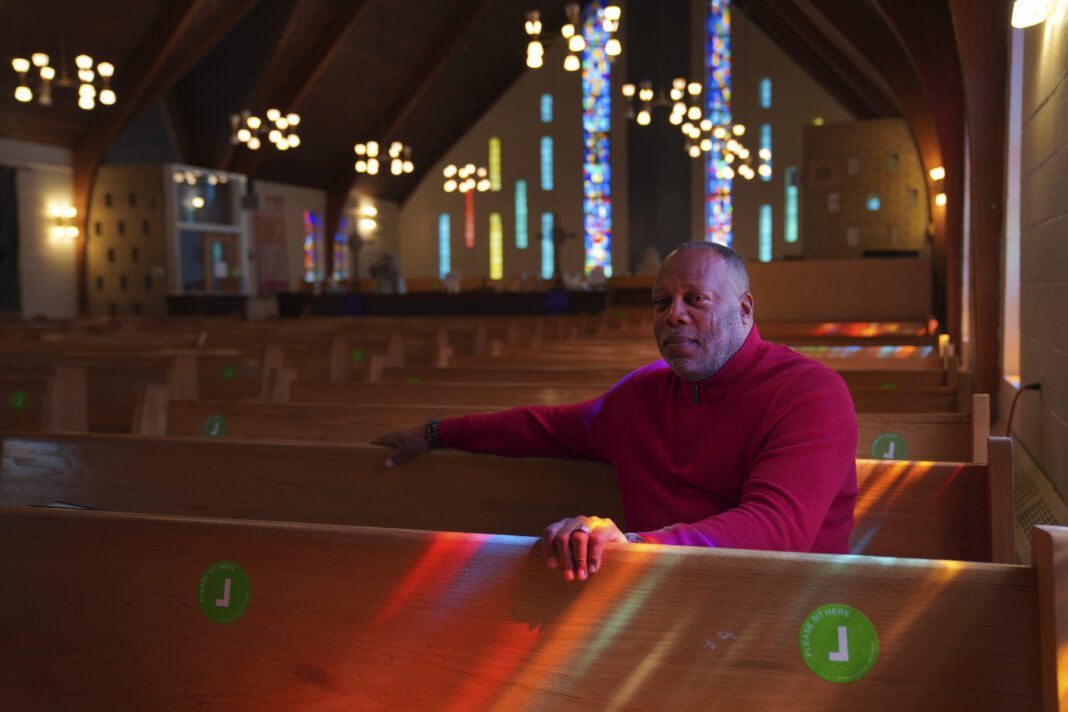PITTSBURGH (AP) — More than 60 years ago, a historic Black church was forced to give up its sanctuary, compensated for what it says was a fraction of its value, to an urban renewal project that wiped out the heart of an African American neighborhood known as the Hill District.
Now, Bethel African Methodist Episcopal Church is poised to recoup some of that loss and reclaim a spot near its former home. It has reached an agreement with the Pittsburgh Penguins — the NHL franchise that now holds development rights to the site near its current arena — for the church to use a 1.5-acre parcel that it envisions using for housing and other revenue-generating development.
“I have never been hockey fan. … Now I’m a hockey fan,” said AME Third District Bishop Errenous McLoud Jr., thanking the Penguins during a news conference Friday preceded by a special worship service on the site Bethel is acquiring. He noted this accord “could and should become a model for reparations all over the world.”
The agreement came after years of public calls and demonstrations by the church. Its battle is a microcosm of a larger one over the legacy of the 1950s project, in which leaders in the Black community have long sought redress from the powers that be in Pittsburgh’s political, business and sports realms.
The Penguins didn’t come into existence until 1967, playing first in one arena in the former neighborhood and now in a newer one nearby.
But Kevin Acklin, president of business operations for the Penguins, said the team is “recognizing our role here as a steward” of the property and its legacy.
“Mistakes that were made 70 years ago, we can’t fix them, but we can do what we can today for a better future, for restorative justice,” Acklin said in an interview.
He hopes the agreement, and the larger efforts to remake the site, can serve as a model for other U.S. cities with the wounds of similar mid-20th century urban renewal projects.
“We have the ability to do good and work with a group of people and a church that’s trying to do good,” he said.
The aptly named Hill District — rising steeply to the east of Pittsburgh’s central business district — became in the 20th century a hub for Black culture, renowned for its jazz clubs and other cultural touchstones portrayed in many of the plays of acclaimed dramatist August Wilson.

Bethel AME had a prominent role in that community. Founded around 1808 and considered Pittsburgh’s oldest Black church, it was active from its earliest years in childhood education and civil rights. It opened a large brick church in 1906 in the Lower Hill District, with rounded arches and a prominent tower, home to 3,000 members at its peak.
But in the 1950s, the Urban Redevelopment Authority of Pittsburgh declared much of the Lower Hill to be blighted. It oversaw demolition of about 1,300 buildings across 95 acres, displacing over 8,000 people, more than 400 business and multiple houses of worship — although not a mostly white Catholic church, as Bethel members have noted.
Bethel leaders fought the church’s demolition unsuccessfully, ultimately receiving $240,000 for a property that had been valued at $745,000.
A cross-town highway, civic arena and some housing were built in the former neighborhood, but other planned structures never materialized.
The result was a concrete and asphalt gash between the downtown and the remaining parts of the Hill District, which continues to struggle economically.
In the beginning, the Penguins played in the original arena and then a newer one nearby after the former was demolished. Under agreements with public authorities, the franchise has development rights to 28 acres of the former arena site. A 26-story mixed-use building is on the rise, and a small urban park has opened, with other projects on the drawing board.
Bethel, meanwhile, now worships further up in the Hill District. Its more modest, modern sanctuary is bathed in the light of stained-glass windows telling stories of the Bible and honoring Methodist stalwarts such as AME pioneer Richard Allen.
In attendance Friday was Bishop Kurt Kusserow of the Southwestern Pennsylvania Synod of the Evangelical Lutheran Church in America. He has supported Bethel in its reparation efforts. The relationship grew out of a Lutheran-AME dialogue that itself was rooted in tragedy — the 2015 racist massacre of nine attendees of a Bible study at Mother Emanuel AME Church in Charleston, South Carolina.
When ELCA leaders learned that the killer had been a member of one of its churches, they called for members of their predominately white denomination to build ties with AME churches.
“As we learned more about white privilege and all of that reality in our country,” Kusserow said, “it was our responsibility to use that privilege in any possible way to accompany what the AME church was seeking in terms of reparations.”
The Rev. Dale Snyder, pastor of Bethel, said the church’s plans for the site include housing and a day-care center, with other possible commercial development.
“This is a model for how we can heal the broken realities of America,” Snyder said.
The Rev. Prudence Harris, an associate pastor and lifelong Bethel member, said she was 5 when she and her parents watched the previous sanctuary being demolished. “I remember my mom crying,” she said. On Friday, Harris said, “she’s shining down.”
Acklin said the 1.5-acre site is larger than the 13,000-square-foot property that Bethel formerly owned, and which has been designated for other uses.
He sees the agreement as part of larger efforts to work with the Hill District community to restore its former connections to downtown.
In 2014, all of the major parties involved — which include the city, county and two public authorities — agreed to a plan intended to include Hill District stakeholders.
But the long process has required vigilance to ensure the new developments benefit the neighborhood, said Marimba Milliones, president of the Hill Community Development Corp.
“When we’re talking about addressing a historic wrong, it has to be for the entire site,” Milliones said.








